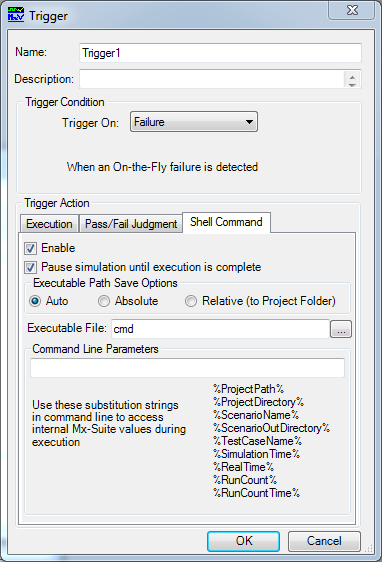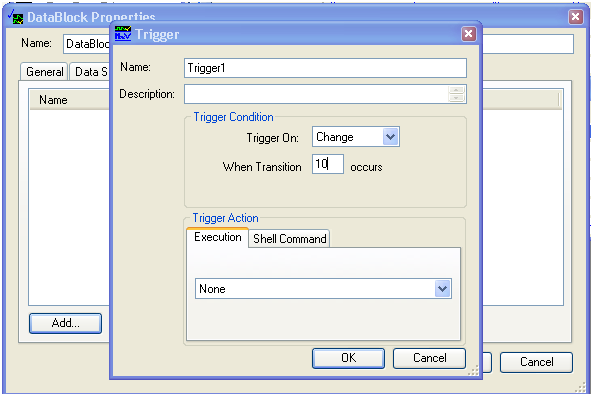Using Triggers
To create a Trigger:
1.Select a DataBlock.
2.Right-click in the Signal Plot Area, then select DataBlock->Properties, or right-click on the red DataBlock bar then select "Properties" from the context menu.

3.Select the Triggers tab.
4.Use the Add, Edit, or Remove buttons to create, change, or delete a Trigger.
5.Enter a name and description of the Trigger. (optional)
6.Set the Trigger Condition and Trigger Action.
7.Click OK.
The trigger is marked in the TestCase with a green arrow:

A trigger in the second DataBlock of a Signal
There are three options for Trigger Condition: •Change - The trigger is fired when the specified transition occurs (as shown in the example below). When counting transitions, it may be helpful to view the Transition List with the ID box checked. However, note that only transitions in the current DataBlock are counted. •Failure - The trigger is fired when a failure is detected on-the-fly. The Project Setting for Pass/Fail Analysis must be set to On-the-Fly; see Project Settings. •Threshold - The trigger is fired when the value of the Signal meets the specified condition relative to the specified Threshold. Options are: greater than, less than, less than or equal to, greater than or equal to, or equal. Note that if you are using a continuous Signal it may not be possible to meet the equal condition, so <= or >= are recommended.
|
There are three tabs to specify the Trigger Action. All triggers, regardless of the specified action, can be used in Relative Time Criteria.
|
Suppose we want to ensure that the time between two Trigger points is correct (this is called a Relative Time Criterion). Consider the image below:
Lets define the first Trigger point as the last pulse in the second sequence of five pulses. We select the second sequence of five pulses and convert it to a DataBlock. Now go into the DataBlock properties:
In the example above, we have defined a Trigger as follows: •The Trigger point is the 10th transition in the second DataBlock (2 transitions for each pulse) •No action will be taken when this Trigger fires Specify a second Trigger on another Signal in the same TestCase. Again, no action is to be taken when the Trigger fires. Then go to the TestCase Properties to specify the Relative Time Criterion. |
Triggers do not work directly with System Signals. However, triggers can be set on probes. To set a trigger on a System Signal, probe it then assign the trigger to the probe. |
Related Topics:
Architectural Concepts - Triggers





